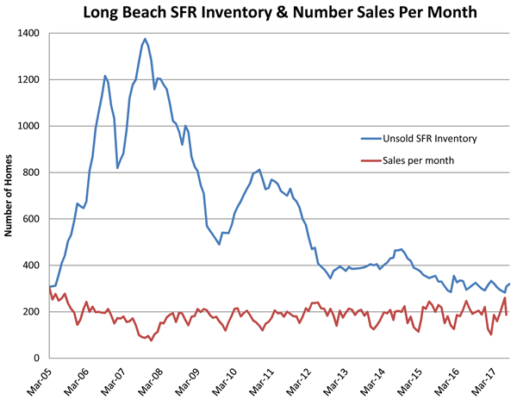 Lately I have had quite a few appointments where sellers were concerned about the future of real estate prices. With homes hitting new highs, they question the sustain ability of the market. My answer has been that I don’t think there is anything to worry about, as long as interest rates remain stable and the economy keeps chugging even if slowly, along.
Lately I have had quite a few appointments where sellers were concerned about the future of real estate prices. With homes hitting new highs, they question the sustain ability of the market. My answer has been that I don’t think there is anything to worry about, as long as interest rates remain stable and the economy keeps chugging even if slowly, along.
Let me show why this concern has some merit, but also why an immanent change in the Real Estate market is not on the horizon, and finally, what signs would be a precursor to a market ready to change directions.
A Tepid Recovery
This economic recovery has been one of the most tepid in history. This mediocre recovery has averaged only around 2% annual growth, while normal recoveries since WWII have usually yielded -4%+ annual growth. To many, this economy feels like they are just keeping their head above water. And, as a result, many question the strength of this economic recovery.
Six year into the Housing Recovery
There has been a strong cyclical nature in California Real Estate, leading to booms and busts. The previous bull phase of the market lasted 10 years (1996 – 2006). This expansion was longer than most, aided by the tail wind of ever lower interest rates. Prior to the 1996 – 2006 bull move was the 1994 to 1990 upswing, which lasted 6 years. Six years for an upswing is typical. The most recent market bottom occurred in 2011, which currently puts us 6 years into the recovery. This does add a certain amount of risk to the market, as we are probably closer to a temporary top in the market versus the previous bottom. This factor alone doesn’t mean price increases are over or that there is a correction right around the corner. It’s just that one might consider more caution.
These two factors, 1) tepid recovery and 2) 6 years into a recovery, have given seller’s their recent concern.
No Correction on the Horizon…….
I don’t think we have the makings of a correction at this point. Homes are still favorably priced. The is the greatest defender of our current price structure. In addition the market is still very strong with low supply relative to demand. Both factors support today’s home prices.
So while there might be a “vibe” that says investors should be concerned, the underlying numbers don’t yet confirm that fear.
Homes are Still Favorably Priced!
Buyers always have a choice NOT to buy. The alternative is to rent. My quick valuation metric is to compare a home’s total payment (Principle, Interest, Taxes & Insurance – PITI) to the fair market rent of a home. In my model, I assume 10% down and then I compare 75% of the PITI payment to the rent. We use the 75% calculation because there are significant tax advantages that come with owning compared to renting.
Let’s take a current example of a 3 bedroom, 2 bath single family home in the Los Altos area of Long Beach that sells for $700,000. The PITI payment with 10% down and 4.0% mortgage would be $3,850 and times 75% would be $2,887. This $2,887 is then the true cost of ownership and should be compared to rent. The typical rent for a $700,000 Los Altos home might be around $2,700 – $3000. Therefore, the purchase premium is almost negligible.
Historically, I very rarely see this number favor renting. There is almost always a small premium to own rather than rent using this metric. Only during the absolute bottom of a market have I seen this metric favor renting because buyers were afraid of buying and fear caused greater price drops than warranted. During the last two peaks this metric showed homes overvalued by 25% in 1990 and by 40% in 2006. While today’s higher home prices may lead one to think that homes could be overvalued, rents have climbed significantly in the last 5 years and interest rates have barely nudged up from their historic lows. Purchasing is still a very solid decision relative to renting.
Technical Analysis of the Market
Before a market breaks, there are usually some signs of trouble. One of the most obvious signs is the ratio of homes on the market versus how many homes sell per month. These two numbers yield the “Months Supply” of homes for sale. Right now there are approximately 300 homes for sale in Long Beach. Every month about 200 homes sell, providing a 45 day supply. This is still very low, which helps support today’s prices.
Look at the corresponding graph below, which goes back to 2005. While the market did not start its downward slide until right after the credit crunch of August 2007, you can see that sales gradually declining before the credit crunch and most notable was the very significant increase in unsold homes. This observation supports a general principle: “Market corrections are almost always preceded by an increase in inventory.”. This has not happened.
In addition, I subscribe to a very involved data service that allows me to slice and dice all home sales in all California. Looking at every market trend for Long Beach, I was not able to find any indication of a “Topping” market. I looked at “Days on Market”, to see if there was any slowing in how long it took homes to sell. I looked at the ratio between list price and sales price to see if buyers were negotiating more and sellers had to give in more to facilitate the sale. I looked at total dollar inflows into the property markets: they were stable giving no indication of slowing market.
Basically, I have seen no physical market evidence, to support a changing or topping market.
We all know that there are cycles to the market place and that trees don’t grow to the sky. That being said, the following is my best guess as to what might create a shift in the market.
Interest Rates – Rates versus Home Prices
Rule of Thumb – 1% change in interest rates = 10% change in home price.
During our last bull run in prices, one year I noticed prices climb 10% during one year-over-year period. Coincidentally, during that same year interest rates fell 1%. When I dug a little further into how this affected a buyer’s total house payment, I noticed that even though home prices went up 10%, a buyer’s payment stayed essentially the same because rates fell 1% during the same time. From a buyer’s perspective, meaning the buyer’s payment, the home didn’t go up at all.
The moral of that story was that the gain in home prices was completely created by the lower interest rate environment not necessarily stronger gains in a buyer’s income.
The obvious negative correlation to this positive outcome is that if rates were to climb, it could cause a steep rise in a buyer’s payments, essentially acting like a price increase or sticker shock.
While it is impossible to predict the future, we can speculate on what might likely put a crimp in the housing market. I believe the biggest threat to housing is a sudden increase in interest rates. Now, do not misread me here, I don’t believe that rates WILL dramatically rise in the future, but that it is possible. How would a sudden increase in rates affect home values? If rates were to suddenly increase from 4% to 6%, this could create a situation where homes today’s fairly valued market would be 20% overvalued. This might cause an immediate pullback in prices. Is this likely to happen? Probably not. But stranger things have happened. It is those things that we don’t expect that always causes market adjustments.
Ever since the credit crisis of 2007, the Federal Reserve has been attempting to slowly unwind the potential danger of a highly leveraged and fragile real estate market. Some might argue that all of the stimulus was a good thing because it kept the markets from going into a free-fall. Other might argue that it has propped up asset prices and made the economy more fragile.
The Investment Markets – Apartments
Everything in the investment world is based upon the theoretical “Riskless” rate of return of long term government bonds and inflation expectations. Right now apartment buildings and commercial buildings are selling for Cap Rates of around 4%. The Cap Rate or Capitalization Rate is simply the amount of NET Annual Income the building produces, divided by the purchase price. Essentially the yield of the property is, like the yield of a bond. Quite a few years ago before yields on money were essentially driven to zero, Cap Rates were more like 6 to 8%. Investors in a search for anything with a yield have bid up the value of income producing assets, correspondingly driving down returns on investment property.
Over the last four years, income-producing property has gone up about 14% per year. It is true that underlying rents have climbed nicely to help validate the gain, but rents have only climbed about 5-7% per year. So the majority of the price increase has come at the expense of a compression in rates of returns on buildings.
If returns on fixed income products go back to a more historical norm, like 4% to 6% on bonds, then Cap Rates on apartments would likely have to move up as well causing prices to adjust downward.
The point of this exercise is not to say that this will happen, but to show how an increase in rates will cause quite a bit of havoc in all financial markets. In addition, our country’s debt obligation would be very difficult to manage if rates were to go up drastically, so the Fed for their own sake will try to keep rates low.
The bottom line is that both the housing market and the apartment market have benefitted greatly from the very low interest rate market that we are experiencing. But now valuations and possibly other financial markets may be dependent upon the continuation of these low interest rates.
Purchasing Long Term versus Speculation
Based upon today’s low rates, homes are fairly valued. For this reason combined with the ability to lock in a fixed rate loan, I see no reason why a qualified buyer in need of a home should wait. Even if rates were to go up and prices go down, a buyer’s payment would be fixed. If a buyer has a long term prospective there should be no risk. Yet for a speculator, somebody looking at hold times less than 5-7 years, the current market has more risk. It is certainly still a good time to be purchasing with a long-term horizon. However, if I were somebody expecting or needing double-digit growth to make an investment work, I would rein in my expectations.
We invite your call regarding any Real Estate questions.
